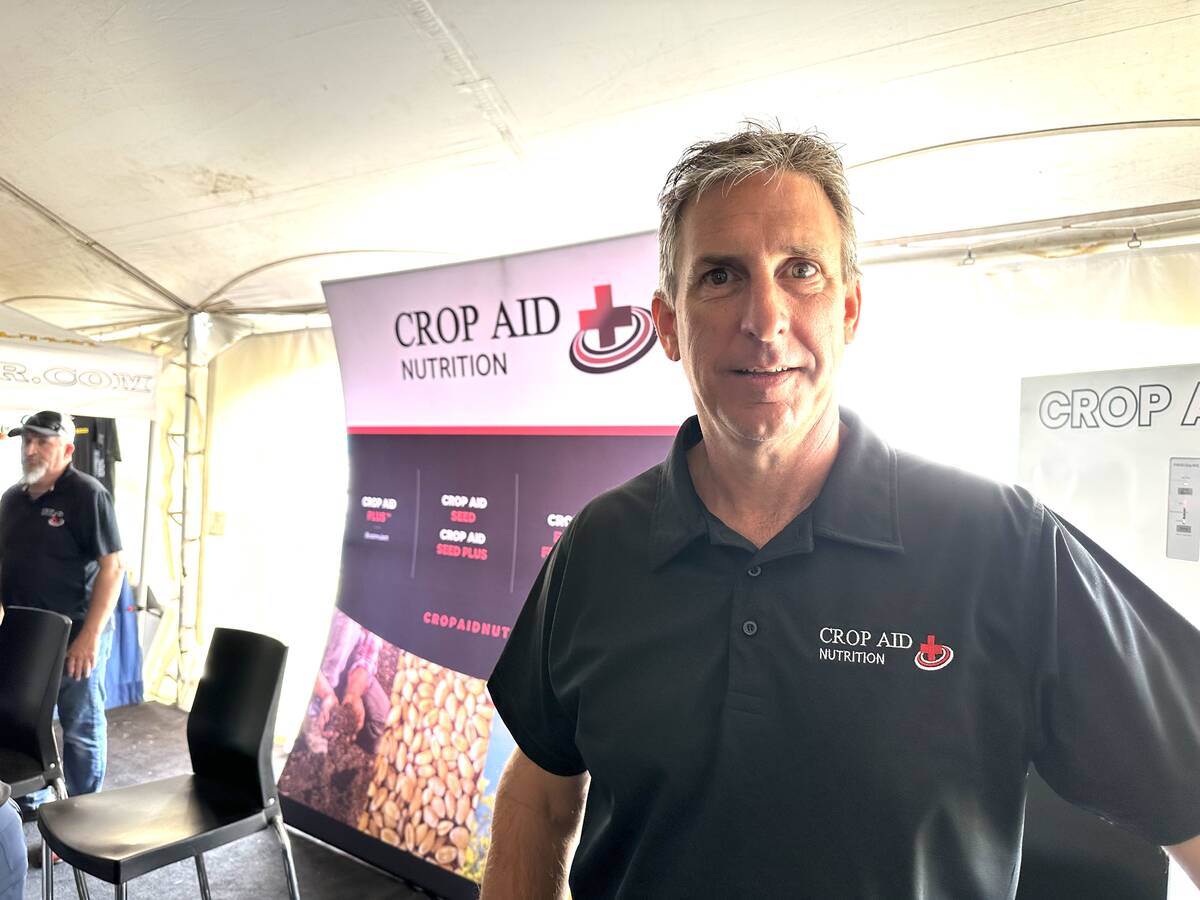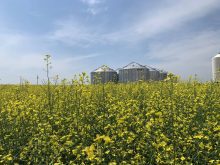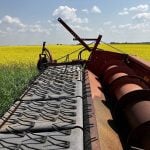Merle Klassen is definitely “in” for competition for the big green prize in 2018.
Klassen, who farms with family members near Linden, about an hour north of Calgary is yield leader so far in a Canada wide contest among canola growers to produce a 100 bushel canola crop. Klassen produced 85.88 bushels per acre on a 50-acre field in 2017.
That puts him at the top of the yield board, edging out the 2016 yield leader Mike Nelson of Wetaskiwin, Alta., who finished the 2016 season with a verified yield of 81.43 bushels per acre on a 50 acre field. Nelson participated in the 2017 contest but hail sidelined his efforts.
Read Also

New soil treatment targets saline patches in fields
Crop Aid SS is a Saskatchewan-made spray that’s intended to help farmers manage saline soils by leaching salts away from the root zone.
The final year of the contest runs through 2018. The first producer to achieve a 100 bushel verified yield on a 50 acre plot wins the grand prize, which is 100 hours of use of a whole fleet of John Deere equipment (seeding to harvest fleet) — that’s the big green prize. If no producer reaches the magic 100-bushel yield, the one with the highest yield over the three-year term of the contest will be awarded the prize. Klassen hasn’t started making room in the yard for the equipment yet.
If the challenge is appealing —it is still really anybody’s game — there is still plenty of time to enrol for the 2018 growing season. The contest is open to producers in all four western provinces and Ontario. You can enter two fields per farm, have them registered by March 31, 2018 and then decide whether to lock those fields in by May 15, 2018. Details available at www.agri-prize.com.
Klassen’s crop of Invigor L233P canola produced about seven bushels more among the top five yields of the 2017 contest.
Curtis Harrish of Calmar, Alta., produced the second-best yield with a Pioneer Roundup Ready — 45CS40 variety at 79.32 bushels.
Third was Andrew Luellau of Olds, Alta., with a Dekalb RR-7565 and a yield of 78.66 bushels.
Fourth place was Chad Badowski of Swan River, Man., also growing InVigor L233P with a yield of 78.58 bushels and fifth was David Harrish of Calmar (Curtis’s dad) growing the same Pioneer variety with a yield of 78.37 bushels.
Fertility was foundation
Klassen is part of a diversified family-run farm near Linden. He looks after cropping operation on about 5,500 acres, while two brothers look after the livestock side of the farm, which includes a 4,500 head beef feedlot, as well as poultry.
“It is certainly gratifying to have the top yield for 2017,” says Klassen. “It is the highest yield we have ever had on this farm.”
Despite some real growing condition extremes in other parts of Western Canada — too dry in many areas and then too wet in others — Klassen says conditions were just about ideal in his area last year.
“Aside from weather, I think the biggest factor contributing to a high yield in 2017 was soil fertility,” says Klassen. The fields he selected had a long history of receiving both raw and composted manure. Along with that he supplied a recommended fertilizer blend that included 120 pounds of nitrogen, 10 pounds of phosphorus, 25 pounds of potassium and 30 pounds of sulphur.
“Aside from fertility the second factor that probably contributed to the high yield were four in-crop treatments with fungicide,” he says.
First job of the growing season involved a spring pre-seeding burndown with Roundup WeatherMAX tank mixed with Conquer. That was followed by seeding InVigor L233P seeded at 4.9 pounds per acre (based on 1,000 seed weight count). And a slight correction from earlier reports, the seeding rate targeted placement of nine seeds per square foot, with a goal to produce a stand of about five plants per square foot.
Of the total fertilizer program, noted above, about 25 lbs. of N, 10 lbs. of P, five lbs. of K, and five lbs. of S was included in the seed row, with the remainder placed beside the seed row. Added fertility at seeding did not factor in any fertility already in the soil.
In crop, the canola was treated with one pass of Liberty Link herbicide tank mixed with Centurion. Klassen also made four fungicide applications during the growing season. He included a bit of the micronutrient boron with the fungicide. And to top up fertility he dribble banded some UAN pre-bolting. With some diamond back moth pressure on the field he also applied an insecticide as well.
The crop was desiccated in early September and then straight cut about 10 days later.
A “moon shot” contest
The Canola 100 contest is co-sponsored by Agri-Trend Agrology, John Deere Canada and Glacier FarmMedia (publishers of Grainews).
“In many respects it was certainly a challenging year for many farmers as far as growing conditions were concerned,” says Rob Saik, former Agri-Trend CEO, who developed the Canola 100 contest idea. “Their success is a testament to improved management ability, and production efficiency. At the same time we are also seeing the benefits of improved crop varieties that perform well even under adverse growing conditions.”
Saik, describing the Agri-Prize contest as a “moon shot” says although no one has reached that 100-bushel yield yet, canola growers are doing an exceptional job at increasing production efficiency and yields.
Saik says the objective behind the contest is to challenge growers to test the limits of their management and agronomic abilities to see what canola can produce.
“We also hope through this contest to create a community of participants who share their knowledge and expertise with each other,” says Saik. “The objective is to inspire farmers toward greater innovation. We want the contest to be a learning experience, but also fun.”
















